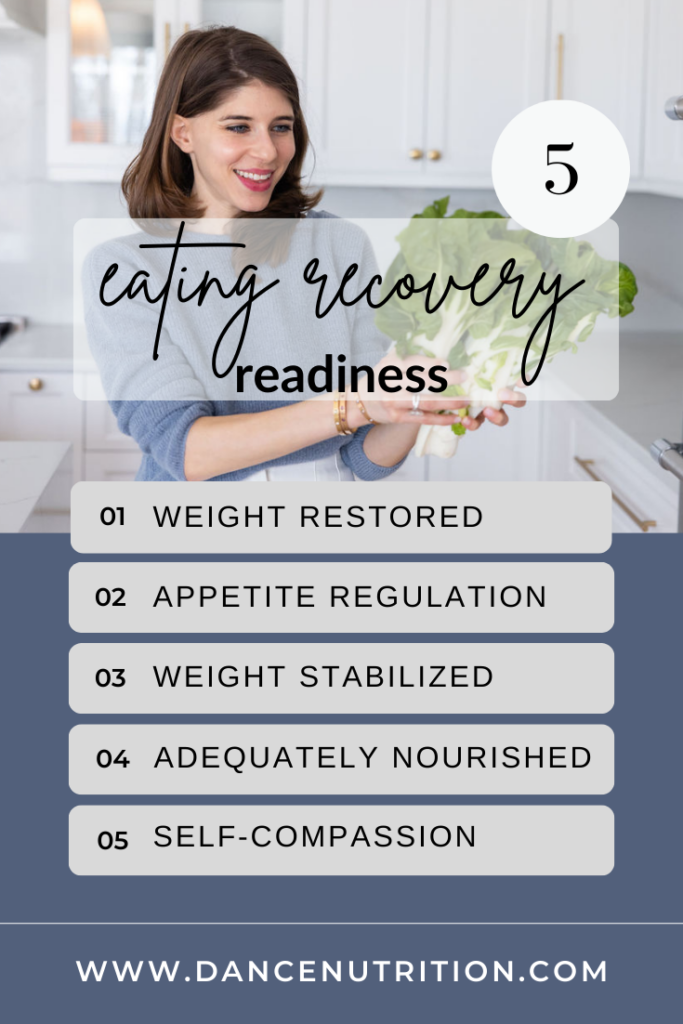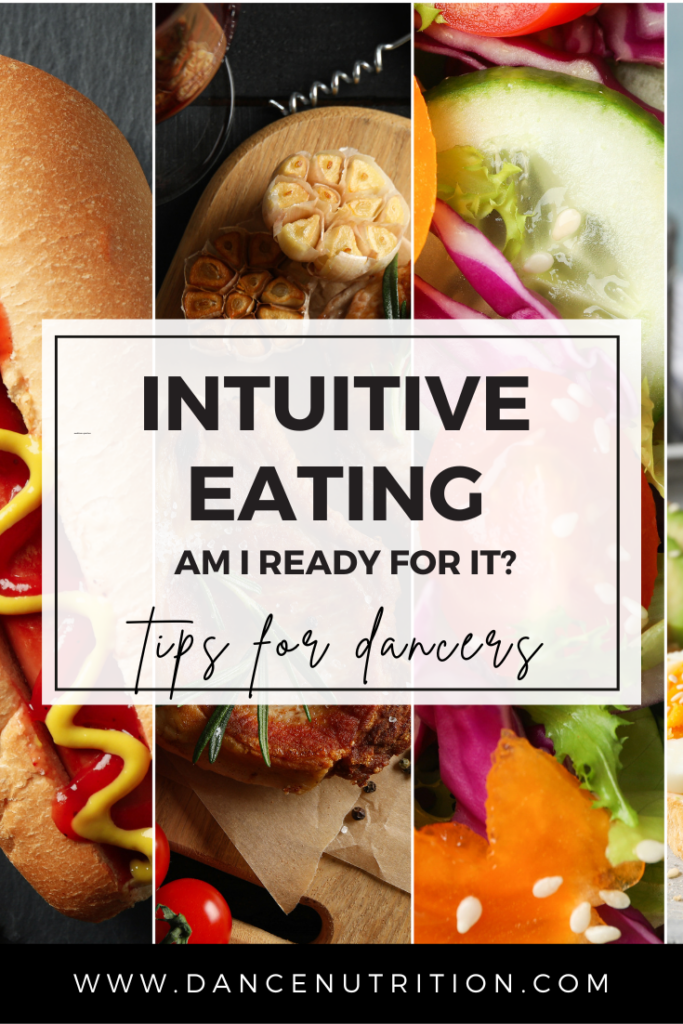For dancers who are moving from restrictive eating behaviors to healing their relationships with food, an ultimate goal is to eat in a way that feels “normal” and less pre-determined.
I’ve previously discussed the role of flexible meal planning for dancers— whether or not a history of disordered eating exists, flexible meal plans ensure adequate nourishment is met throughout a busy dance day. Despite this, learning how to loosen the reigns at mealtimes is the ultimate goal and intuitive eating is a lifestyle practice that can be a useful tool for dancers along their journeys of healing from disordered eating, chronic dieting, or moving through recovery from an eating disorder.
But here’s a disclaimer: loosening the reigns shouldn’t be mistaken for a “carefree” approach to eating (a technique that I don’t recommend for dancers, and here’s why). Part of the intuitive eating paradigm that often gets lost in translation is the need for adequate nourishment. Even for those who are not struggling with disordered eating, relying on flexible meal planning can help to support practical hunger (a topic I discuss here).
Transitioning away from meal plan reliance offers space to integrate a more intuitive approach to food. As a Registered Dietitian, this is a common technique that we use in the later stages of eating disorder recovery— only after one has made major strides in healing their relationship with food.
What does it look like to heal your relationship with food?
A supportive relationship with food can look different for everyone, but generally, it allows for food to nourish the body in a way that feels neutral and pleasurable, while honoring the options that are accessible to you. Food and nutrition can be part of this, but only if utilized in a way that doesn’t feel overwhelming or obsessive.
I’ve previously discussed how dancers can shift their perspective to gradually build a supportive relationship with food. This involves a consistent and proactive effort to challenge diet-culture messaging with the goal of prioritizing personal preferences and satisfaction, not external calorie counts or food rules. A few other key examples of a supportive relationship with food include:
- The ability to identify and honor comfortable levels of hunger and fullness throughout your day.
- The ability to honor your hunger without self-doubt.
- A compassionate perspective that allows you to understand the reasons behind behaviors often perceived as “bad” or “destructive” (ie. emotional eating, mindless eating, and “over” eating).
- The ability to trust yourself around foods deemed more indulgent.
- The ability to elicit flexibility around food.
Should I be eating intuitively?
Intuitive eating, as discussed in this guide, involves rejecting the dieting mentality, building body awareness towards internal cues of hunger, fullness, and satisfaction, challenging unattainable body beliefs, allowing for unconditional permission to eat without guilt, and learning how to incorporate nutrition science and joyful movement without risking obsessive behaviors. But intuitive eating— especially for dancers, cannot be the first and only step in your journey towards building a supportive relationship with food.
For some, it can take years before an intuitive approach is helpful. In fact, while I’m a certified counselor of Intuitive eating, only a portion of the principles are used within The Healthy Dancer®. This is because of the ten principles of Intuitive Eating, two are nearly impossible for dancers at the beginning stages of recovery— “Honor your hunger” and “Feel your fullness.” Busy and active lifestyles disrupt a dancer’s ability to rely on hunger and fullness cues, and a history of restrictive eating (whether those restrictions are intentional or unintentional) exacerbates this.
Am ready to eat intuitively?
It’s important to understand that not every dancer will be ready for this stage of recovery because as mentioned earlier, an intuitive approach is only recommended after a dancer has unraveled much of what diet culture sets forth. Working alongside a Registered Dietitian Nutritionist is also highly encouraged at this stage. To identify whether or not you’re ready, evaluate if these five truths can apply to you.
#1: You are not actively restoring your weight
Weight restoration is a specific term used in eating disorder recovery. When supporting a dancer’s weight restoration, we are aiming for a set-point weight range that is supportive of the body’s physical and metabolic needs (more on this, here). It not only encompasses the process of weight gain but also, weight stability over time. Weight restoration is often the first and most important step in eating disorder recovery and one that I always encourage dancers to seek professional support for (working alongside a licensed dietitian and mental health professional).
#2: You experience appetite regulation
As you’re healing your relationship with food, it’s common to experience extremes in hunger and fullness— in fact, many dancers find themselves eating past a point of physical comfort during the early stages of recovery. For some, the somatic response of physical fullness can feel new and scary, and even small amounts of food can result in discomfort. This is a normal part of the recovery process.
As your appetite regulates, you are able to identify comfortable levels of hunger and fullness. It takes time to figure out an amount of food that feels comfortable and alongside this might come the need to unravel beliefs surrounding portion sizes.
#3: You’re not attempting to micromanage your weight
One of the more challenging steps in a dancer’s recovery is reevaluating body ideals. For some, this also involves a reevaluation of their dance environment— a studio and/or company that celebrates body diversity and steers clear or weight checks (yes, these sadly still happen in the dance world). Click here to learn more about body ideals in dance and how you can implement starting stages to rebuild your body image.
#4: You’re committed to prioritizing adequate nourishment
At this point, you should be familiar with tools like food flexibility and food neutrality (two are major components within The Healthy Dancer® and I’ve linked helpful articles to each above. Food flexibility allows for spontaneous eating experiences that don’t stress you out, even when those involve foods you had previously deemed off-limits.
#5: You’ve confidently replaced self-ridicule with self-compassion
Behaviors often perceived as “bad” or “destructive” (ie. emotional eating, mindless eating, and “over” eating) are ones that might come and go even when one is healed from disordered eating. Rather than focusing on these behaviors as being “setbacks,” it’s important to acknowledge the reality that as humans, we will try to seek comfort during times of discomfort. To maintain your newfound relationship with food, it might be important to continue to sustain a supportive team (this might involve check-ins with your dietitian and mental health provider). Here are a few additional articles as you navigate these specific challenges:




